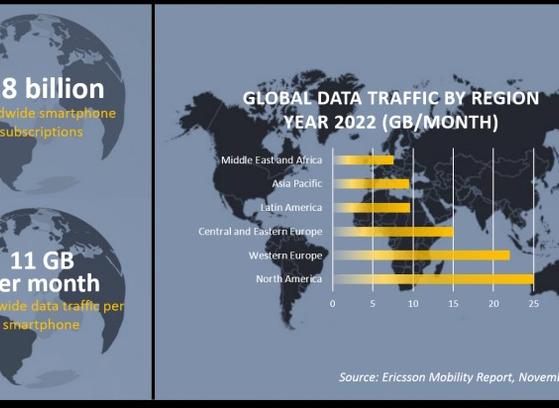TEMS™ Infovista recently sponsored the 5G North America event in Dallas, TX, where one of our resident experts, Dr. Irina Cotanis, participated in two panel sessions. Recently we sat down with Dr. Cotanis to ask her some questions about Infovista's TEMS solutions and the emergence of 5G. (Note: This is a technical discussion, so get your telephony dictionary handy just in case.)
What potential do you think there is for the use of advanced antenna technologies to improve the performance of LTE?
LTE-A comes with enhanced MIMO (4x4, 8x8) which theoretically double/triple data rates per resource block compared to 2x2 MIMO. However, there are two main reality check issues which will actually determine the overall performance improvement, and operators are still evaluating these:
- Theory applies based on the assumption that the paths are uncorrelated (“multipath richness”) and signal-interference-to-noise ratio (SINR) is very high, conditions that are not all the time and/or not in all areas possible to be met. The expected result is that performance will definitely increase, just not to the theoretical limits.
- For a downlink (DL) case, 4 Tx antennas started to be already implemented at BS/eNBs, but devices with 4Rx are behind due to the obvious reason of hardware limitations/constrains that such a technological complexity creates. However, it will still be the benefit of 4x2 (1 stream on 2 antennas) with Tx diversity. For the uplink (UL) case, 4 Rx at BS/eNBs helps with about more 3dB in link budget based on 4 RX diversity. Therefore, it is today's user equipment (UE) technology that still hinders achieving theoretical limits.
As for 8x8, this is more at lab phase along with all the other approaches that come with 5G NR, like massive MIMO (e.g. 64x64, 128x128,256x256), beamforming or tracing (demoed by various parties at MWC 2016).
In a nutshell, yes, antenna technologies are expected to increase LTE performance but for sure not at theoretical limits.
What potential do you think there is for the use of unlicensed spectrum to improve the performance of LTE?
I would argue that it is not only about LTE performance but also Wi-Fi performance. We should not be network biased; unlicensed spectrum needs to ensure “fairness” for both types of networks since both are crucial for further evolution towards 5G.
As of today we talk about three technologies: LTE-U (Rel 10-12) and LTE-LAA (Rel13), Qualcomm's MuLTEfire, and 5GHz spectrum. LTE-U involves channel selection and carrier sensing adaptive transmission (CSAT) schemes, which can be prone to cross technology interference artefacts. That is why LBT (listening before talk) has been introduced as improvement with LAA. The Qualcomm solution is LAA based, but does have some additional features based on LTE performance as well as Wi-Fi as well. A major benefit of LAA is that it is integrated with licensed LTA CA (DL and UL), unlike LTE-U, which is DL only and as a supplemental CA. In a nutshell, it is clear that LAA will benefit both LTE and Wi-Fi performance, and is therefore expected to take off. However, how fast and/or at what extent and/or in which regions is still an industry game.
What potential do you think there is for the use of RAN optimisation technologies to improve the performance of LTE?
There is a lot of potential for RAN optimization in LTE, and actually this is the final goal of the planned-for new releases beyond LTE-A, respectively LTE-Pro and LTE-Pro+, which are coming with a set of new features/technologies expected to help optimize LTE towards better performance, from minimizing interference (e/adaptive ICIC DL/UL, CoMP DL/UL, soft cells, splitting user and data plans) to increased coverage (especially cell fringe) with 4x4/8xMIMO, and increased capacity (64+ QAM). In addition, we started to see more and more distributed SON ANR and MLB (mobility load balance) use cases, as well as self-healing implemented by vendors, with the final scope optimization towards performance and efficiency improvement.
What impact do you think LTE-Advanced Pro deployments will have on the timeline of rollouts of 5G?
I would argue that LTE-Pro deployments are key for 5G phase 1 expected in 2018. Even more, it is unlikely that a 5G release would be available by 2018 without LTE—Pro/Pro+ features/technologies in place. This is also the reason why 5G phase 1 has LTE as anchor technology, with 5G being envisioned as the anchor post 2018.
What are the challenges involved in moving to cloud RAN (C-RAN) and how can they be addressed?
 C-RAN comprehends several baseband units (BBUs) which will serve a multitude of remote radio heads (RRHs) IP (generally optic fiber) connected (front end). Unlike individual cell sites, C-RAN might pose two main challenges:
C-RAN comprehends several baseband units (BBUs) which will serve a multitude of remote radio heads (RRHs) IP (generally optic fiber) connected (front end). Unlike individual cell sites, C-RAN might pose two main challenges:
- A failure at a BBU will affect a large number of RRHs, where before only a particular cell failed.
- Some BWD limitations depending on the traffic and the BBUs and RRHs configurations. Generally, at RRHs only the modulation is transmitted, but if the physical information is transmitted as well, then broadcast messages, mobility messages, paging messages, etc. need to be transmitted as well, in which case BWD limitations may occur.
How can operators go about increasing the number of sites and backhaul connections that will be required for 5G?
5G network densification is expected to be area centric, in the sense that malls, shopping centers, downtowns, enterprise/office building areas will mostly need densification. Therefore C-RAN is the solution, since using BBUs servers will cut off to a large extent the number of required front end as well as backhaul connections. In addition, it will be easier manageable since it is about only the server maintenance rather than a large number of cells.
Is TEMS already taking steps towards 5G VoLTE/ViLTE?
As pioneers in VoLTE testing (very first VoLTE network and device at T-MO/ MetroPCS working with Ericsson and Samsung), as well as ViLTE (working with Ericsson Research and testing in US first tier operators' networks as well as working with CMCC Research), we had the opportunity to discover first-hand the VoLTE/ViLTE challenges from the unique perspective of the real user. This gave us the advantage to develop our VoLTE/ViLTE portfolio and solutions to efficiently address VoLTE/VilTE challenges, with drive testing solutions (outdoor and indoor), core/IMS, and now, through our acquisition by Infovista, call trace based solutions.
Today, mobile network operators (MNOs) understand that the most cost efficient way of maintaining VoLTE/ViLTE is through virtualization. Virtualization also plays a significant role for network scalability and flexibility, key characteristics of the future 5G networks. Our TEMS IMS VoLTE solution is ready to go either as a virtualized remote client as well as virtualized within network client, and/or as a hardware component. As a virtualized remote solution, TEMS Monitor Master can help in the initial phase with regression testing, and later with continuous monitoring of KPIs.
About Irina Cotanis
 Dr. Irina Cotanis holds an M.S. and an Doctorate in Electrical Engineering, and a scorecard of more than 20 years of experience in wireless communications systems, statistical signal processing and analysis, and statistics, as well as more than of 10 years as active member in standardization organizations, and of more than 100 publications, (e.g. IEEE conference papers, standards and student books). Her expertise covers three main areas: 3G/LTE/LTE-A field measurements and data analysis techniques, QoE models and metrics, and network and services quality assurance (QoS/QoE) management. Since SON started to get shape her work focuses on developing models for autonomic measurements dedicated to assist self-diagnosing/ healing/configuring networks based on machine learning mechanisms acting from the subscriber perception's perspective on 4G/LTE-A/SON services' quality. In her role as CTO office member, Dr. Cotanis works on defining TEMS technological strategies. Dr. Irina Cotanis earned during the years international recognition as patent author as well as author of standards, technical specification and several white contributions to ITU-T — Study group 12 (Performance, QoS and QoE), Video Quality Expert Group (VQEG) and European Telecommunications Standards Institute (ETSI). She published in international technical conference proceedings (IEEE) and acted as reviewer to IEEE journals articles and international conferences papers as well as session chair to various IEEE conferences.
Dr. Irina Cotanis holds an M.S. and an Doctorate in Electrical Engineering, and a scorecard of more than 20 years of experience in wireless communications systems, statistical signal processing and analysis, and statistics, as well as more than of 10 years as active member in standardization organizations, and of more than 100 publications, (e.g. IEEE conference papers, standards and student books). Her expertise covers three main areas: 3G/LTE/LTE-A field measurements and data analysis techniques, QoE models and metrics, and network and services quality assurance (QoS/QoE) management. Since SON started to get shape her work focuses on developing models for autonomic measurements dedicated to assist self-diagnosing/ healing/configuring networks based on machine learning mechanisms acting from the subscriber perception's perspective on 4G/LTE-A/SON services' quality. In her role as CTO office member, Dr. Cotanis works on defining TEMS technological strategies. Dr. Irina Cotanis earned during the years international recognition as patent author as well as author of standards, technical specification and several white contributions to ITU-T — Study group 12 (Performance, QoS and QoE), Video Quality Expert Group (VQEG) and European Telecommunications Standards Institute (ETSI). She published in international technical conference proceedings (IEEE) and acted as reviewer to IEEE journals articles and international conferences papers as well as session chair to various IEEE conferences.
About TEMS™ Infovista
TEMS™ Portfolio encompasses a complete set of trusted solutions for drive testing, analyzing, benchmarking, and monitoring mobile network performance, is now part of Infovista.
Infovista is the global provider of network performance orchestration solutions. Together with TEMS, Infovista serves eighty percent of the world's largest CSPs, more than 250 MNOs, countless global enterprises, and regulatory bodies worldwide, backed by a workforce of over 800 employees in 20 countries. Our award-winning solutions including TEMS™ empower mobile operators and communications service providers to ensure a high-quality subscriber experience across the entire lifecycle, all technologies and all domains of both the mobile and fixed networks. Our state-of-the-art offerings will continue to facilitate planning, deployment, optimization, monetization, and maintenance of mobile telecommunications networks at the service of a better connected and collaborative world.










